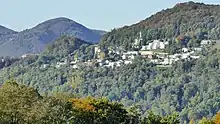
Agra is a village and former municipality in the canton of Ticino, Switzerland.
In 2004 the municipality was merged with the other, neighboring municipalities Gentilino and Montagnola to form a new and larger municipality Collina d'Oro.[1]
History
The hamlet of Bigogno, which is part of Agra, is first mentioned in 1270 in an inventory of the lands of the monastery of S. Abbondio in Como in the Valle di Lugano.[2] The inventory of Como Cathedral (1298) mentions their allodial titles and episcopal loans in Agra as well as possessions of the Disentis Abbey. The same document also mentions the church of S. Tommaso in Agra. The church initially belonged to the parish of S. Pietro in Pambio and then became an under-parish in 1591. The Chapel of S. Assunta in Bigogno was completed before 1609. In the statutes of Como from 1335, the Concilium or Vicinanza of Agra and Premona or Barbengo is first mentioned.
In addition to agriculture, the village was once famous for training and sending artisans to Russia along with other European nations. In 1912 a regional sanatorium opened in the village. It was a residence to for many, especially German-speaking, notables and intellectuals. They published the monthly magazine Die Terrasse (The Terrace) from the sanatorium. It was closed in 1969 and fell into disrepair.[2]
Location

The village is located at an elevation of 570 m (1,870 ft) at the foot of Monte Crocione.
 Church of Saint Tommaso
Church of Saint Tommaso On the right the village Agra
On the right the village Agra Dining room of the former sanatoriums (1950)
Dining room of the former sanatoriums (1950)
Historic population
The historical population is given in the following chart:[2]

References
- ↑ Amtliches Gemeindeverzeichnis der Schweiz published by the Swiss Federal Statistical Office (in German) accessed 14 January 2010
- 1 2 3 Agra in German, French and Italian in the online Historical Dictionary of Switzerland.
- Agra in German, French and Italian in the online Historical Dictionary of Switzerland.